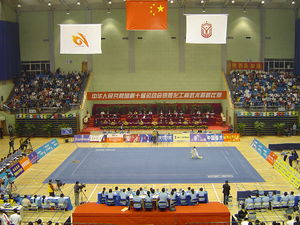| Wushu | |||
|---|---|---|---|
| Traditional Chinese | 武術 | ||
| Simplified Chinese | 武术 | ||
| Literal meaning | martial arts | ||
|
|||
| Part of the series on Chinese martial arts |
 |
| List of Chinese martial arts |
|---|
| Terms |
|
| Historical places |
|
| Historical people |
|
| Famous modern actors |
|
| Legendary figures |
|
| Related |
|
Competitive wushu is composed of two disciplines: taolu (套路; forms) and sanda (散打; sparring).Taolu involve martial art patterns and maneuvers for which competitors are judged and given points according to specific rules. The forms comprise basic movements (stances, kicks, punches, balances, jumps, sweeps and throws) based on aggregate categories of traditional Chinese martial art styles and can be changed for competitions to highlight one's strengths. Competitive forms have time limits that can range from 1 minute, 20 seconds for some external styles to over five minutes for internal styles. Modern wushu competitors are increasingly training in aerial techniques such as 540 and 720 and even 900 degree jumps and kicks to add more difficulty and style to their forms.
Sanda (sometimes called sanshou or Lei tai) is a modern fighting method and sport influenced by traditional Chinese boxing, Chinese wrestling methods called Shuai jiao and other Chinese grappling techniques such as Chin Na. It has all the combat aspects of wushu. Sanda appears much like Kickboxing or Muay Thai, but includes many more grappling techniques. Sanda fighting competitions are often held alongside taolu or form competitions.


